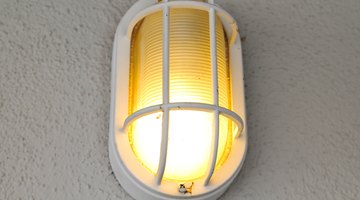How to Rid a House of Miller Moths
The Miller moth, also called the army cutworm moth, is a common household pest, even though they don’t damage clothing or any other property and are harmless to people and pets.

Gray or brown with spots or squiggly blunt lines on its delta-shaped wings, Miller moths are about an inch in length, and the caterpillar that becomes the moth feeds on leaves, especially those of grains. The extent of the damage they cause may be a dusty residue on windows they bump into, but for many people the Miller moth is a nuisance.
Things You Will Need
- Fly swatter
- Wide-brimmed bowl
- Liquid soap
- Conical shade desk lamp
-
Use a fly swatter to kill any moths you see, or vacuum up their dusty little carcasses when you find them. Although the life cycle of the adult Miller moth is months long, they will die within a few days without a steady source of nectar on which to feed. Even if you are dealing with an infestation, they will usually die off quickly.
-
Examine all open grain-based products in your home for army cutworms, and discard infested products. Army cutworms resemble tomato worms but are much smaller. They have green with somewhat segmented bodies. The army cutworms hatch from eggs between late summer and autumn, and they feed throughout the winter. Because they pupate only in soil, the caterpillars will likely die out before they can become moths. To prevent invading moths from laying eggs in your home, store all your grain-based products in airtight containers or in the refrigerator for two weeks until the moths have all died off.
-
Leave your porch lights -- front and back porches -- off at night as much as possible. As with all moths, lights attract Miller moths.
-
Fill a wide bowl with soapy water -- dish-washing liquid works well -- and position a conical shade desk lamp one foot above the bowl at night when you go to bed if Miller moths infest your house. The light will attract the moths, and when they get close enough for the heat of the bulb to stun them, they will drop into the bowl and drown. The soap acts as a surfactant, reducing surface tension on the water so the moths will sink when they come into contact with the water.




Tip
Avoid planting cherry trees, horse chestnuts, Russian olive trees, raspberry bushes and aromatic flowering plants such as spirea and lilacs near any entrance to your house. The nectar produced by these plants attracts Miller moths, making it more likely that they will find their way through a door or window.
The Drip Cap
- The Miller moth, also called the army cutworm moth, is a common household pest, even though they don’t damage clothing or any other property and are harmless to people and pets.
- The extent of the damage they cause may be a dusty residue on windows they bump into, but for many people the Miller moth is a nuisance.
- They have green with somewhat segmented bodies.
- Because they pupate only in soil, the caterpillars will likely die out before they can become moths.
Writer Bio
Tom Wagner began writing for newspapers and magazines in the L.A. area in 2001. With articles appearing in "California Examiner," "World Reporter," the "Philippine Nurses Monitor" and "Famegate Global News," he currently writes for all three Philippine Media publications in Los Angeles, San Diego and Las Vegas. His articles focus on food, social issues, travel, sight-seeing, humor, general information, politics and medical matters.
Photo Credits
- Dale Davidson/Demand Media
- Dale Davidson/Demand Media
- Dale Davidson/Demand Media
- Dale Davidson/Demand Media
- Dale Davidson/Demand Media
- Dale Davidson/Demand Media
More Articles



